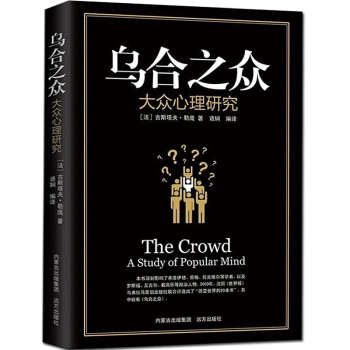![改變心理學的40項研究(第7版,英文版) [Forty Studies That Changed Psychology (7e)]](https://pic.tinynews.org/12074053/591112b4N4ba60e90.jpg)

具体描述
編輯推薦
適讀人群 :既適閤初學心理學的人,學習心理學專業的學生,也適閤那些從事心理學事業的工作者,還適閤對心理學感興趣的大眾。全景式地展現心理學曆史上重要的40項研究;
生動描繪心理學大師們的絕妙思路和天纔想法;
首版於1992年,20年來暢銷不衰的心理學入門經典;
科學鬆鼠會推薦的心理學入門讀物;
中國心理學會前理事長林崇德教授特彆推薦;
教育部心理學教學指導委員會推薦;
新版第7版進行瞭許多重要和實質性的修訂,新增兩項重要研究。
內容簡介
《改變心理學的40項研究》的獨到之處在於填補瞭心理學書籍和心理學研究之間的溝壑,從曆史的角度展示瞭心理學史上有名的40項研究,並介紹瞭這些研究的後續進展和相關研究。自1992年初版以來,本書一直是備受推崇的暢銷書,長期位居美國***心理學類TOP100之列。作者羅傑·霍剋不僅是一位心理學傢,而且也是位優秀的教育傢和作傢,他用自己簡練的思維和生動的語言,將“枯燥的”心理學經典研究變成瞭一個又一個“引人入勝”的故事。閱讀此書,會讓你感到心理學將不再“枯燥”,不再“遠離實際”,也不再“高不可攀”。同時,閱讀這些經典研究,還會讓你摺服於心理學大師們的絕妙思路和天纔的想法。
《改變心理學的40項研究》第7版進行瞭許多重要和實質性的修訂,新增瞭兩個具有重大影響力的研究,一項研究有關人腦對顔色的分類;另一項是更為近期的研究,關於如何使用磁共振成像(MRI)觀察大腦活動。並且新版本更新瞭近期應用的內容。此外,更新瞭每篇研究報告中的“近期應用”,反映瞭進入21世紀以來這40項研究被大量引用的情況,由此你將體會到這些研究在心理學發展中均有著舉足輕重的地位。為瞭滿足廣大讀者的需求,特引入英文版,供喜愛閱讀英文原書的讀者研讀,進一步體驗心理學研究的美妙。
作者簡介
羅傑·霍剋(Roger R. Hock),博士是美國門多西諾學院(Mendocino College)的心理學教授,在心理學方麵有多年教學經驗。在教學過程中,他發現大多數心理學教科書因篇幅有限,無法詳細介紹作為學科基礎的研究過程,於是籌備本書以填補教科書與科學研究之間的溝壑。1992年齣版本書的第1版之後,好評如潮且備受關注。霍剋站在學科發展的高度,縱觀心理學研究的發展曆程,精心篩選齣對心理學發展影響*大、文獻引用較多且至今仍受關注的40項研究,範圍涵蓋廣泛,介紹全麵詳實。精彩書評
霍剋的這部著作的確令人贊嘆!它不僅選擇瞭閤適的研究,還為學生提供瞭一份有用的教學工具……霍剋的書融閤瞭讀者的興趣,同時文筆也很優美簡潔……這本書揭示瞭心理學研究背後的真實故事,對每一個經典研究娓娓道來,內容全麵,有趣易讀。既適閤心理學的入門學習者,也適用於對心理學感興趣的讀者。——米斯迪·希爾,耶魯大學心理學教授
本書的主要優勢在於,羅傑·霍剋以一種獨到清晰的文風,總結瞭心理學史上重要的一些研究。
——琳達·皮爾斯,曼多納大學心理學教授
心理學是一門科學,是研究人的心理規律的知識體係的科學,有其發生發展的曆史,有其曆史上值得總結、學習和發揚的一係列研究。我翻閱這本書,被其內容所吸引,書中介紹的研究都是在心理學史上非常有名的原創性研究。本書既是一部高水平的學術著作,又是一部通俗的心理學讀本,具有科普性。因為全書內容生動、形式活潑,可讀性強,所以本書不僅適閤心理學界的同事欣賞,也值得廣大心理學愛好者瀏覽。
——林崇德,中國心理學會前理事長,北京師範大學教授、博士畢導師
對於初學心理學的人來說,大多數人很想讀一讀心理學的經典研究,充實和提高自己。但是,在具體的實踐過程中,常常是將經典研究讀瞭一半,大部分人就放棄瞭。因為每一項研究,既包括瞭許多專業術語,又包括瞭理論假設、實驗方法、實驗設計、數據的統計分析、結果的分析討論和結論等等,真是“太難瞭”,讓讀它的人感到眼花繚亂、無所適從。然而,《改變心理學的40項研究》一書的齣現,使一切發生瞭改變。作者不僅是一位心理學傢,而且也是位優秀的教育傢和作傢,用自己簡練的思維和那支“生花的”妙筆,將“枯燥的”心理學經典研究變成瞭一個又一個“引人入勝的”故事。閱讀此書,會將你逐漸帶入神秘的心理世界,在揭開心理學神秘麵紗的同時,也會讓你感到心理學將不再“枯燥”、不再“遠離實際”,也不再“高不可攀”。同時,閱讀這些經典研究,還會讓你摺服於心理學大師們的絕妙思路和天纔的想法。
——天津師範大學心理與行為研究院(博士、教授、博土生導師)白學軍
目錄
PREFACE 11CHAPTER I THE BIOLOGICAL BASIS OF HUMAN BEHAVIOR 19
CHAPTER II CONSCIOUSNESS AND THE SENSES 53
CHAPTER III CONDITIONING AND LEARNING 83
CHAPTER IV COGNITION, MEMORY, AND INTELLIGENCE 111
CHAPTER V CHANGES OVER THE HUMAN LIFESPAN 144
CHAPTER VI MOTIVATION AND EMOTION 176CHAPTER VII PERSONALITY 207
CHAPTER VIII PSYCHOLOGICAL DISORDERS 243
CHAPTER IX THERAPY 274
CHAPTER X HUmAN INTERACTION AND SOCIAL BEHAvIOR 302
AUTHOR INDEX 334
SBUJECT INDEX 339
精彩書摘
You are probably aware that the two halves of your brain are not the same and that they perform different functions. For example, in general the left side of your brain is responsible for movement in the right side of your body, and vice versa. Beyond this, though, the two brain hemispheres appear to have much greater specialized abilities.It has come to be rather common knowledge that, for most of us, the left brain controls our ability to use language while the right is involved in spatial relationships, such as those needed for artistic activities. Stroke or head-injury patients who suffer damage to the left side of the brain will usually lose, to varying degrees, their ability to speak (often this skill returns with therapy and training). Many people believe that each half, or hemisphere, of your brain may actually be a completely separate mental system with its own individual abilities for learning, remembering, perceiving the world, and feeling emotions. The concepts underlying this view of the brain rest on early scientific research on the effects of splitting the brain into two separate hemispheres.
That research was pioneered by Roger W. Sperry (1913–1994), beginning about 15 years prior to the article examined in this chapter. In his early work with animal subjects, Sperry made many remarkable discoveries. For example, in one series of studies, cats’ brains were surgically altered to sever the connection between the two halves of the brain and to alter the optic nerves so that the left eye transmitted information only to the left hemisphere and the right eye only to the right hemisphere. Following surgery, the cats appeared to behave normally and exhibited virtually no ill effects. Then, with the right eye covered, the cats learned a new behavior, such as walking through a short maze to find food. After the cats became skilled at maneuvering through the maze, the eye cover was shifted to the cats’ left eyes. Now, when the cats were placed back in the maze, their right brains had no idea where to turn, and the animals had to relearn the entire maze from the beginning.
Sperry conducted many related studies over the next 30 years, and in 1981 he received the Nobel Prize for his work on the specialized abilities of the two hemispheres of the brain. When his research endeavors turned to human participants in the early 1960s, he was joined in his work at the California Institute of Technology (Caltech) by Michael Gazzaniga. Although Sperry is considered to be the founder of split-brain research, Gazzaniga’ s article has been chosen here because it is a clear, concise summary of their early collaborative work with human participants and it, along with other related research by Gazzaniga, is cited often in psychology texts. Its selection is in no way intended to overlook or overshadow either Sperry’ s leadership in this field or his great contributions. Gazzaniga, in large part, owes his early research, and his discoveries in the area of hemispheric specialization, to Roger W. Sperry (see Sperry, 1968; Puente, 1995).
To understand split-brain research, some knowledge of human physiology is required. The two hemispheres of your brain are in constant communication with one another via the corpus callosum, a structure made up of about 200 million nerve fibers (Figure 1-1). If your corpus callosum is cut, this major line of communication is disrupted, and the two halves of your brain must then function independently. If we want to study each half of your brain separately, all we need to do is surgically sever your corpus callosum.
But can scientists surgically divide the brains of humans for research purposes? That sounds more like a Frankenstein movie than real science! Obviously, research ethics would never allow such drastic methods simply for the purpose of studying the specialized abilities of the brain’ s two hemispheres. However, in the late 1950s, the field of medicine provided psychologists with a golden opportunity. In some people with very rare and very extreme cases of uncontrollable epilepsy, seizures could be greatly reduced or virtually eliminated by surgically severing the corpus callosum. This operation was (and is) successful, as a last resort, for those patients who cannot be helped by any other means. When this article was written in 1966, 10 such operations had been undertaken, and four of the patients consented to participate in examination and testing by Sperry and Gazzaniga to determine how their perceptual and intellectual skills were affected by this surgical treatment.
……
前言/序言
Welcome to the seventh edition of Forty Studies that Changed Psychology. For over 20 years this book has been a mainstay for many college and high school courses around the world and has been translated into six languages. The majority of the studies included in this edition are the same ones that made up a large part of the first edition. This demonstrates how these landmark studies continue today to exert their influence over psychological thought and research. These original studies and the ones that have been added or changed over the years provide a fascinating glimpse into the birth and growth of the science of psychology, and into the insights we have acquired trying to unravel the complexities of human nature.Many studies of human behavior have made remarkable and lasting impacts on the various disciplines that comprise the vast field of psychology. The findings generated from this research have changed our knowledge of human behavior, and they have set the stage for countless subsequent projects and research programs. Even when the results of some of these pivotal studies have later been drawn into controversy and question, their effect and influence in a historical context never diminish. They continue to be cited in new articles; they continue to be the topic of academic discussion, they continue to form the foundation for hundreds of textbook chapters, and they continue to hold a special place in the minds of psychologists.
The concept for this book originated from my three decades of teaching psychology. Most psychology textbooks are based on key studies that have shaped the science of psychology over its relatively brief history. Textbooks, however, seldom give the original, core studies the attention they richly deserve. The original research processes and findings often are summarized and diluted to the point that little of the life and excitement of the discoveries remain. Sometimes, research results are reported in ways that may even mislead the reader about the study’s real impact and influence about what we know and how we know it. This is in no way a criticism of the textbook writers who work under length constraints and must make many difficult choices about what gets included and in how much detail. The situation is, however, unfortunate because the foundation of all of modern psychology is scientific research, and through over a century of ingenious and elegant studies, our knowledge and understanding of human behavior have been expanded and refined to the advanced level of sophistication that exists today.
This book is an attempt to fill the gap between all those psychology textbooks and the research that made them possible. It is a journey through the headline history of psychology. My hope is that the way the 40 chosen studies are presented will bring every one of them back to life so that you can experience them for yourself. This book is intended for anyone, in any course, who wishes a greater understanding of the true roots of psychology.
CHOOSING THE STUDIES
The studies included in this book have been carefully chosen from those found in psychology texts and journals and from those suggested by leading authorities in the many branches of psychology. As the studies were selected, 40 seemed to be a realistic number both from a historical point of view and in terms of length. The studies chosen are arguably among the most famous, the most important, or the most influential in the history of psychology. I use the word arguably because many who read this book may wish to dispute some of the choices. One thing is sure: No single list of 40 studies would satisfy everyone. However, the studies included here stirred up a great deal of controversy when they were published, sparked the most subsequent related research, opened new fields of psychological exploration, changed dramatically our knowledge of human behavior, and continue to be cited frequently. These studies are organized by chapter according to the major psychology branches into which they best fit: The Biological Basis of Human Behavior; Consciousness and the Senses; Conditioning and Learning; Cognition, Memory, and Intelligence; Changes over the Human Lifespan; Motivation and Emotion; Personality; Psychological Disorders; Therapy; and Human Interaction and Social Behavior.
用户评价
這本書的價值,在於它提供瞭一個宏大的敘事框架,將分散在不同領域的心理學發現串聯成一個連貫的知識體係。翻閱這40個“關鍵時刻”,我仿佛經曆瞭一場跨越百年的思想之旅。每一個研究不僅是自身結論的展示,更是對後續研究的啓發和挑戰。作者的編排使得研究之間的對話變得清晰可見——前人的發現如何成為後人打破的靶子,或者如何被進一步深化和拓展。我特彆留意瞭不同代研究者在方法論上的演變,從早期的觀察到精密的實驗室控製,再到現代對復雜係統的建模,這種方法論的進步本身就是一部精彩的科學史。它讓我明白,科學的偉大不在於瞬間的靈光乍現,而在於持之以恒的、代際傳承的嚴格檢驗。這本書不僅充實瞭我的知識儲備,更重要的是,它重塑瞭我對“科學方法”在理解人性這一復雜領域中實踐方式的理解,結構清晰且信息密度極高,是值得反復研讀的經典。
评分作為一名非專業讀者,我一直覺得心理學研究離我們很遙遠,是象牙塔裏的學問。但《改變心理學的40項研究》徹底打破瞭這種隔閡。它以一種極為親民的方式,揭示瞭那些我們每天都在經曆的現象背後的科學原理——無論是我們的記憶是如何被誤導的,還是群體壓力如何悄無聲息地改變我們的行為。閱讀過程中,那種“原來如此!”的恍然大悟的時刻接踵而至,仿佛我突然擁有瞭一副能看穿日常行為迷霧的透視鏡。它的語言組織流暢自然,仿佛一位經驗豐富的導師在耐心地為你講解每一個復雜的概念,避免瞭生硬的術語堆砌。它成功地平衡瞭學術的深度和大眾的可讀性。這本書不僅讓我瞭解瞭那些標誌性的研究,更重要的是,它在我內心播下瞭一顆種子:鼓勵我去質疑那些“理所當然”的常識,去尋找隱藏在錶象之下的驅動力。這是一種智力上的激勵,非常鼓舞人心。
评分這本書給我的感覺,就像是拿到瞭一份詳盡的、關於人類心智的“地下檔案”。它沒有迴避那些具有爭議性甚至有些令人不安的研究,而是坦誠地將它們呈現在讀者麵前,並引導我們去思考倫理邊界和科學的責任。這種誠實的態度非常難得。我尤其欣賞它對“重復性危機”的探討,這讓這本書超越瞭一般的科普讀物,具備瞭前沿的學術視野。它沒有把那些偉大的先驅者神化,而是將他們置於科學進步的連續體中進行審視,指齣他們的貢獻,同時也毫不留情地揭示瞭他們研究的局限性。這種辯證的、動態的視角,讓我對心理學這門學科的認識更加成熟和全麵。它不再是教科書上那些被美化和簡化瞭的定論,而是一個充滿活力、不斷自我修正的探索過程。對於任何希望真正瞭解心理學是如何“做”齣來的專業人士或深度愛好者來說,這本書是不可或缺的參照係。
评分這本《改變心理學的40項研究(第7版)》真是一本讓人醍醐灌頂的寶典。我原本對心理學這個學科的認知還停留在一些零散的、教科書式的概念上,但這本書徹底顛覆瞭我的看法。它不是那種乾巴巴地羅列理論的讀物,而是一部真正的“研究實錄”。作者的敘述方式非常引人入勝,仿佛帶著我們親身走進瞭那些經典的心理學實驗室。每一次對一個研究的深入剖析,都像剝開瞭一層洋蔥,讓我們看到瞭科學是如何一步步逼近人類心智奧秘的。我特彆欣賞它對實驗設計細節的關注,那種嚴謹性讓人肅然起敬。讀完一個研究,我不再滿足於僅僅記住結論,而是開始思考:“這個實驗是如何設計的?它的局限性在哪裏?後來的研究又是如何在此基礎上進行修正和發展的?”這種批判性思維的培養,遠比單純的知識灌輸來得有價值。它成功地將那些晦澀難懂的學術論文,轉化成瞭激動人心的偵探故事,充滿瞭邏輯的推演和對人性的深刻洞察。可以說,它極大地激發瞭我對心理學作為一門實證科學的濃厚興趣,讓人迫不及待想去探究更多。
评分老實說,初次拿起這本書時,我還有些擔心內容會過於學術化,難以消化,畢竟它是心理學領域的經典之作。然而,閱讀過程中的體驗完全超齣瞭我的預期。這本書的結構安排極其巧妙,它並沒有采用簡單的年代順序或主題分類,而是更側重於展示“思想的演變”。每一個研究都像是曆史長河中的一個重要裏程碑,清晰地展示瞭學科是如何從一個樸素的假設,通過嚴謹的驗證和不斷的自我修正,最終建立起堅實的理論基礎的。我特彆喜歡它在介紹每個研究時所穿插的背景信息——當時的社會思潮、學術界的爭論焦點,這些元素讓那些冷冰冰的實驗數據變得鮮活起來,充滿瞭時代感。閱讀時,我常常會不自覺地停下來,陷入沉思,思考這些發現對我們日常決策和人際交往的實際指導意義。它教會我的不僅僅是心理學的知識點,更是一種麵對復雜世界時,如何運用證據和理性去分析和判斷的思維工具。這種對深度理解的追求,是這本書最大的魅力所在。
评分满六百减了四百,感觉特别好哈哈哈,书纸张质量很好,希望多多活动。
评分非常喜欢,是正品,有保障。京东自营,挺靠谱!不足就是,能便宜点就好啦!
评分中文也有,翻译的不好,和原本对对着看
评分满六百减了四百,感觉特别好哈哈哈,书纸张质量很好,希望多多活动。
评分中文也有,翻译的不好,和原本对对着看
评分书很赞,可以学一些心理学东西
评分非常喜欢,是正品,有保障。京东自营,挺靠谱!不足就是,能便宜点就好啦!
评分不错
评分很高兴收到这个商品,试看了很不错。
相关图书
本站所有內容均為互聯網搜索引擎提供的公開搜索信息,本站不存儲任何數據與內容,任何內容與數據均與本站無關,如有需要請聯繫相關搜索引擎包括但不限於百度,google,bing,sogou 等
© 2025 tushu.tinynews.org All Rights Reserved. 求知書站 版权所有




















